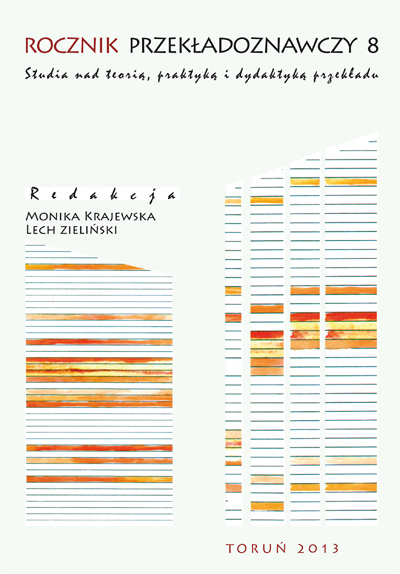Nić Ariadny / Le fil d’Ariane ‒ czyli o międzyjęzykowej ekwiwalencji mitologizmów frazeologicznych
DOI:
https://doi.org/10.12775/RP.2013.002Słowa kluczowe
ekwiwalencja międzyjęzykowa, frazeologizmy, mitologia greckaAbstrakt
W artykule poruszony został problem ekwiwalencji polskich i francuskich frazeologizmów mających swe źródło w mitologii. W badaniach nad tym zagadnieniem istotne jest rozpoznanie struktury formalnej i semantycznej związków. Przedstawiona analiza pokazuje, że znaczenie frazeologizmów może być wyrazem swoistych doświadczeń i odmiennej interpretacji zjawisk. Zatem wspólne źródło związków nie zawsze implikuje równoważności na poziomie ich składu leksykalnego i globalnego znaczenia. Z kolei porównanie sposobu obrazowego ujęcia treści frazeologizmów pozwala dostrzec pewne odrębności na poziomie pojęciowym. Zebrane przykłady zostały pogrupowane według różnych poziomów ekwiwalencji międzyjęzykowej.Bibliografia
Ballard, M., 2003, Versus: la version réfléchie anglais – français, I, Paris, Ophrys.
Bartmiński, J., 2006, Językowe podstawy obrazu świata, Lublin, Wydawnictwo UMCS.
Capra, A., 2010, „Traduttore traditore: de la possibilité de traduire les expressions figées en littérature”, Revue interdisciplinaire Textes & contextes [en ligne], 5: „Stéréotypes en langue et en discours”. Disponible sur Internet: wersja elektroniczna tekstu dostępna pod adresem: http://revuesshs.u-bourgogne.fr/textes&contextes/document.php?id=1303 (dostęp: 30 września 2012 r.).
Chlebda, W., 1997, „Biblizmy języka polskiego i rosyjskiego. Koncepcje opisu leksykograficznego”, [w:] Współczesny język polski i rosyjski. Konfronatacja przekładowa, A. Bogusławski, J. Mędelska (red.), Warszawa, Katedra Lingwistyki Formalnej, s. 23–66.
Dąmbska-Prokop, U., 2000, „Ekwiwalencja”, [w:] Mała Encyklopedia Przekładoznawstwa, U. Dąmbska-Prokop (red.), Częstochowa, s. 68–75.
Giermak-Zielińska, T., 2000, Les expressions figées. Propositions pour un traitement contrastif, Varsovie, Publications de l’Institut de Philologie Romane de Varsovie.
Hejwowski, K., 2004, Kognitywno-komunikacyjna teoria przekładu, Warszawa, PWN.
Lecolinet, T., 2007, Termes de la mythologie: évolution de sens ou de forme endiachronie, Université de Franche-Comté, praca doktorska niepublikowana.
Misri, G., 1990, „La traduction des expressions figées”, [w], Etudes traductologiques en hommage à D. Seleskovitch, M. Lederer (red.), Paris, Minard, s.143–163.
Nida, E., 1964, Towards the Science of Translating, New York, Prentice Hall.
Oleśkiewicz, A., 2007, Europa języków Związki frazeologiczne o proweniencji biblijnej i antycznej w europejskiej wspólnocie słownikowej, Kraków, Collegium Colombinum.
Pisarska, A., Tomaszkiewicz, T., 1996, Współczesne tendencje przekładoznawcze, Poznań, Wydawnictwo Naukowe UAM.
Puda-Blokesz, M., 2011, „Frazeologizmy pochodzenia mitologicznego w języku polskim (zasób, stan i perspektywy opisu)”, [w:] Perspektywy współczesnej frazeologii polskiej Teoria. Zagadnienia ogólne, S. Bąba, K. Skibski, M. Szczyszko (red.), Poznań, Wydawnictwo UAM, s. 121–141.
Rejakowa, B., 1986, Związki frazeologiczne o identycznej lub podobnej budowie morfologicznej w języku słowackim i polskim, Wrocław–Warszawa, Ossolineum.
Rejakowa, B., 1994, Mechanizmy językowe w przekładzie związków frazeologicznych, Lublin.
Skibińska, E., 1999, Przekład a kultura: elementy kulturowe we francuskich tłumaczeniach „Pana Tadeusza”, Wrocław, Wydawnictwo Uniwersytetu Wrocławskiego.
Skorupka, S., 1985, „Stan i perspektywy frazeologii porównawczej w Polsce”, Z problemów frazeologii polskiej i słowiańskiej, II, s. 7–15.
Tabakowska, E., 1998, „Profilowanie w języku i tekście – perspektywa językoznawcy, tłumacza i poety”, [w:] Profilowanie w języku i tekście, J. Bartmiński, R. Tokarski (red.), Lublin, Wydawnictwo UMCS, s. 167-184.
Tokarski, R., 2001, „Słownictwo jako interpretacja świata”, [w:] Współczesny język polski, red. J. Bartmiński, Lublin, Wyd. UMCS, s. 343–370.
Vinay, J.-P., Darbelnet, J., 1958, Stylistique comparée du français et de l’anglais, Paris, Didier.
Pobrania
Opublikowane
Numer
Dział
Statystyki
Liczba wyświetleń i pobrań: 1228
Liczba cytowań: 0



